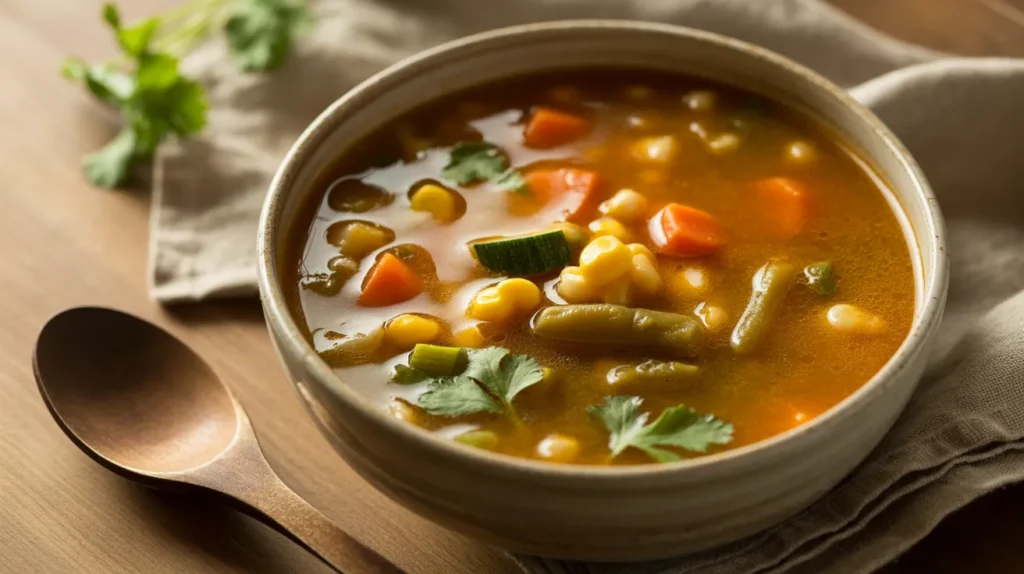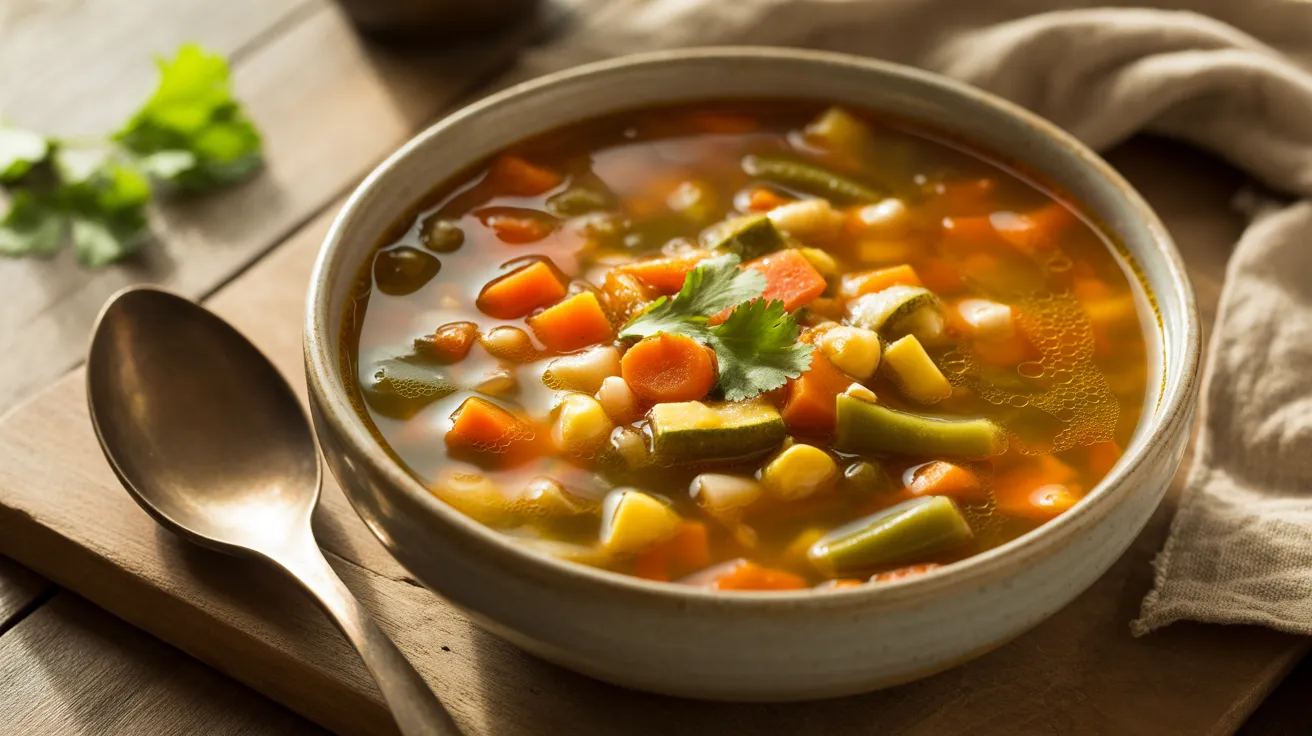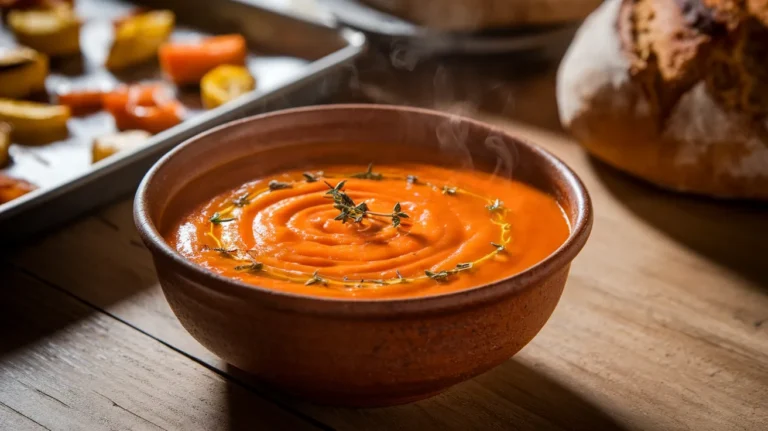This authentic Sopa De Verduras brings together fresh vegetables in a rich, comforting broth that’ll warm you from the inside out. My favorite weeknight dinner combines classic Latin flavors with garden-fresh ingredients, creating a bowl of pure comfort that serves four hungry people perfectly.
SERVES: 4 | PREP: 15 MIN | COOK: 30 MIN | TOTAL: 45 MIN
Ingredients for Sopa De Verduras
Aromatic Base
| Ingredient | Amount |
|---|---|
| Olive oil | 2 tablespoons |
| Yellow onion, diced | 1 medium |
| Garlic cloves, minced | 4 cloves |
| Celery stalks, chopped | 2 stalks |
Main Vegetables
| Ingredient | Amount |
|---|---|
| Carrots, peeled and diced | 2 large |
| Russet potatoes, cubed | 2 medium |
| Zucchini, diced | 1 medium |
| Green beans, trimmed | 1 cup |
| Corn kernels (fresh or frozen) | 1 cup |
| Roma tomatoes, diced | 2 large |
Broth & Seasonings
| Ingredient | Amount |
|---|---|
| Vegetable broth (low sodium) | 6 cups |
| Tomato paste | 2 tablespoons |
| Ground cumin | 1 teaspoon |
| Dried oregano | 1 teaspoon |
| Bay leaves | 2 leaves |
| Salt | 1½ teaspoons |
| Black pepper | ½ teaspoon |
| Fresh cilantro, chopped | ¼ cup |
| Lime wedges for serving | 1 lime |
Step-by-Step Instructions
Phase 1: Building the Flavor Base (8 minutes)
Step 1: Heat your 2 tablespoons olive oil in a large, heavy-bottomed pot over medium heat for about 2 minutes.
The oil should shimmer slightly but not smoke—this tells you it’s ready to cook without burning your aromatics.
Step 2: Add the diced onion and cook for 4 minutes, stirring every minute.
You’ll know they’re ready when they turn translucent and smell sweet, not when they’re brown. Brown means you’ve gone too far and added bitterness to your Sopa De Verduras.
Step 3: Toss in your minced garlic and chopped celery, stirring constantly for 90 seconds.
Garlic burns fast—that’s why we add it after the onions have softened. Your kitchen should smell amazing right now, and that smell means you’re building the soup’s foundation correctly.
Step 4: Stir in the 2 tablespoons tomato paste and cook for 2 minutes without stopping your stirring motion.
This step caramelizes the tomato paste, which removes the raw, metallic taste and adds depth. You’ll see the paste darken slightly and stick to the bottom of the pot—that’s exactly what we want.
Phase 2: Adding Vegetables (3 minutes)
Step 5: Add your cumin, oregano, salt, and black pepper to the pot, stirring for 30 seconds.
Toasting spices in oil before adding liquid unlocks their essential oils and makes them more fragrant. This technique separates okay soup from restaurant-quality Sopa De Verduras.
Step 6: Add the diced carrots and cubed potatoes first, stirring to coat them in the seasoned oil.
These vegetables take longest to cook, so they go in before the others. Each piece should glisten with the aromatic oil you’ve created.
Step 7: Stir in your diced tomatoes and cook for 2 minutes until they start breaking down.
Fresh tomatoes add brightness that canned versions can’t match. You’ll see them release juice and soften around the edges.
Phase 3: Building the Soup (20 minutes)
Step 8: Pour in all 6 cups of vegetable broth and add the 2 bay leaves.
Scrape the bottom of your pot while pouring to lift any brown bits—that’s concentrated flavor you don’t want to waste.
Step 9: Increase heat to high and bring the Sopa De Verduras to a rolling boil.
You’ll see large bubbles breaking the surface rapidly. This should take about 4-5 minutes.
Step 10: Once boiling, reduce heat to medium-low until you see a gentle simmer.
A simmer shows small bubbles occasionally breaking the surface, not the aggressive bubbling of a boil. This gentler cooking keeps vegetables from turning to mush.
Step 11: Cover the pot with a lid slightly tilted to let steam escape, and cook for 12 minutes.
Set a timer! The potatoes and carrots need this exact time to become tender without falling apart.
Step 12: Add your zucchini, green beans, and corn to the pot, stirring gently.
These cook faster than root vegetables, which is why they go in later. If you’d added them earlier, they’d be mushy by now.
Step 13: Cook uncovered for 8 more minutes, stirring once halfway through.
Test a potato piece with a fork—it should slide in easily but the potato should hold its shape. That’s your signal that everything’s perfectly cooked.
Phase 4: Finishing Touches (2 minutes)
Step 14: Remove the pot from heat and fish out the bay leaves with a spoon.
Bay leaves have done their job adding subtle earthiness. Don’t leave them in—they’re not meant to be eaten.
Step 15: Taste your Sopa De Verduras and adjust the salt if needed.
Everyone’s taste buds differ, and different broths have different sodium levels. Start with a small pinch and taste again after stirring.
Step 16: Stir in the fresh chopped cilantro right before serving.
Adding herbs at the end keeps them bright green and fresh-tasting. Heat destroys their delicate flavor, so never cook cilantro for more than a minute.
Step 17: Ladle the soup into four bowls and serve each with a lime wedge on the side.
That squeeze of fresh lime juice brightens every spoonful and cuts through the richness of the broth.
Chef’s Notes
Vegetable Prep Matters: Cut all vegetables roughly the same size (about ½-inch pieces) so they cook evenly. Larger pieces will stay crunchy while smaller ones turn mushy—neither makes good Sopa De Verduras.
Broth Quality Counts: Use the best vegetable broth you can afford. Low-quality broth tastes flat and salty, while good broth adds body and complexity. If you’ve made roasted red pepper soup before, you know how much broth quality affects the final dish.
Don’t Skip the Sauté: That initial 8 minutes of cooking aromatics in oil creates the soup’s flavor backbone. Rushing this step by adding everything at once gives you vegetable water, not proper soup.
Temperature Control: Keep your simmer gentle—aggressive boiling breaks vegetables apart and makes the broth cloudy. You want tender vegetables floating in clear, flavorful broth.
Nutrition Facts (Per Serving)

| Nutrient | Amount |
|---|---|
| Calories | 185 |
| Protein | 5g |
| Carbohydrates | 34g |
| Fiber | 7g |
| Fat | 6g |
| Sodium | 580mg |
Sopa De Verduras Variations
Hearty Protein Version
Add 1 cup cooked chickpeas or 1 cup shredded chicken in Step 13 with the quick-cooking vegetables. The protein makes this a complete meal that’ll keep you full for hours.
Spicy Mexican Style
Stir in 1 diced jalapeño with the garlic and add ½ teaspoon chipotle powder with the other spices. This version rivals any restaurant’s spicy vegetable soup.
Creamy Comfort Bowl
Blend 1 cup of the finished soup until smooth, then stir it back into the pot. This creates a slightly creamy texture without adding dairy—perfect if you loved the texture in sweet potato soup.
Summer Garden Special
Replace green beans and corn with 1 cup diced bell peppers and 1 cup fresh spinach (added in the last 2 minutes). This lighter version celebrates summer’s bounty.
Storage & Reheating
Refrigerator Storage: Let your Sopa De Verduras cool completely (about 30 minutes), then transfer to airtight containers.
It’ll keep for 5 days in the fridge. The flavors actually improve overnight as everything melds together.
Freezer Storage: This soup freezes beautifully for up to 3 months.
Cool completely, portion into freezer-safe containers, and leave 1 inch of headspace since liquid expands when frozen. Label with the date—frozen soup all looks the same after a month.
Reheating: Thaw overnight in the fridge if frozen, then reheat gently over medium-low heat for 8-10 minutes, stirring occasionally.
Don’t microwave on high power—it creates hot spots that overcook some vegetables while others stay cold. Use 50% power for 3-4 minutes instead, stirring halfway through.
Troubleshooting Your Sopa De Verduras
Problem: Vegetables Are Mushy
Solution: You either cut them too small or cooked them too long. Next time, cut vegetables into ½-inch pieces and follow the timing exactly—12 minutes for hard vegetables, 8 minutes for tender ones.
Problem: Soup Tastes Bland
Solution: You didn’t build enough flavor in the aromatics, or you’re using low-quality broth. Sauté your onions, garlic, and celery the full time listed, and always toast your spices in oil before adding liquid. Also, taste before serving and add salt—undersalting is the most common mistake home cooks make.
Problem: Broth Is Too Thin
Solution: You added too much liquid or didn’t let the tomato paste caramelize properly. Simmer uncovered for 10 extra minutes to reduce and concentrate the flavors. The tomato paste step creates body, so don’t rush it.
Problem: Potatoes Are Still Hard
Solution: Your heat was too low, or you cut them too large. Potatoes need a proper simmer (gentle bubbles) to cook through. If they’re still hard after the cooking time, cover and simmer 5 more minutes, testing every 2 minutes.
Problem: Too Salty
Solution: Your broth was higher in sodium than expected. Add 1 peeled, quartered potato and simmer for 10 minutes—the potato absorbs excess salt. Remove it before serving. You can also add more vegetables or a splash of water to dilute the saltiness.
Equipment Essentials
- Large heavy-bottomed pot or Dutch oven (at least 5-quart capacity)
- Sharp chef’s knife for efficient vegetable prep
- Cutting board (preferably two—one for aromatics, one for other vegetables)
- Wooden spoon for stirring without scratching your pot
- Measuring cups and spoons
- Ladle for serving
- Vegetable peeler for carrots and potatoes
Shopping List by Store Section
Produce Section
- 1 yellow onion
- 1 head of garlic
- 2 celery stalks
- 2 large carrots
- 2 medium potatoes
- 1 zucchini
- 2 Roma tomatoes
- 1 bunch cilantro
- 1 lime
Canned/Boxed Goods
- 2 boxes vegetable broth (32 oz each)
- 1 small can tomato paste
Frozen Foods (Optional)
- 1 bag frozen corn (if not using fresh)
Pantry/Spices
- Olive oil
- Ground cumin
- Dried oregano
- Bay leaves
- Salt
- Black pepper
Success Secrets for Perfect Sopa De Verduras
1. Uniform Cutting Saves the Day Spend an extra 2 minutes cutting vegetables the same size. This single step prevents some pieces from being crunchy while others dissolve into the broth.
2. Taste as You Go Check the seasoning after adding vegetables and again before serving. Salt levels change as vegetables release water, so what tasted perfect at Step 8 might need adjustment at Step 15.
3. The Lime Squeeze Changes Everything Fresh lime juice added at the table brightens every spoonful and makes the vegetables taste more vibrant. It’s not optional—it’s essential.
4. Low and Slow for the Simmer Resist cranking up the heat to cook faster. A gentle simmer (not a rolling boil) keeps vegetables tender but intact, giving you that perfect texture.
5. Make It a Day Ahead This Sopa De Verduras tastes better the next day after the flavors have married. Make it tonight, refrigerate, and reheat tomorrow for even better results.
Serve your Sopa De Verduras with warm crusty bread or tortilla chips for scooping. This recipe proves that simple vegetables, treated with care and proper technique, create something truly special.




